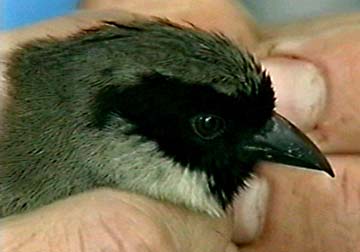
One of last remaining
po‘ouli is captured for
breeding effort
One of the last three po'ouli birds known to exist has been captured and taken to a breeding center on Maui.
Officials hope to capture a mate for the female bird and begin the reproduction process in hopes of saving the species.
Six members of the Maui Forest Bird Recovery Project team captured the bird Thursday afternoon in the Hanawi Natural Area Reserve on Maui. It was taken to the Maui Bird Conservation Center at Olinda.
"Saving this species from extinction is a monumental challenge," said Peter Young, head of the state Department of Land and Natural Resources.

|
He cited strong collaboration between state agencies and the Zoological Society of San Diego. The society operates the Maui breeding center and the Keauhou Bird Conservation Center on the Big Island.
The recovery team has been trying to capture a po'ouli since February 2003. The decision to bring the last three birds into a captive breeding program was made in 2003 after repeated efforts to bring them together in the wild failed.
The team plans to take a few days off to regroup and see how the bird adapts to captivity, said Kirsty Swinnerton, project coordinator. "Then, we'll be back in the field, trying to locate and capture the other two birds."
"Establishing a breeding pair of po'ouli may be the most challenging task we've ever attempted," said Alan Lieberman, avian conservation coordinator for the Zoological Society. He said several other Hawaiian bird species have been successfully bred and reintroduced into the wild, but said starting with only three birds, all of which are at least 6 years old, "increases the difficulties."
"Without this effort, this unique species could go the way of the dinosaur, since the last three remaining birds are found in different areas of the forest and have no chance to reproduce in the wild," said Gina Shultz, endangered species manager for the U.S. Fish and Wildlife Service in Hawaii. "This successful capture and transfer to Olinda breathes new hope for saving the nation's most endangered bird."
The po'ouli is part of the Hawaiian honeycreeper family, but is so unique it has its own genus. It was not discovered until 1973, when a group of University of Hawaii students conducting research on the east slope of Haleakala sighted a bird they had never seen before.
www.state.hi.us/dlnr/mfbp